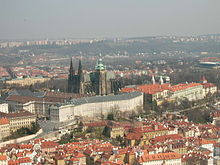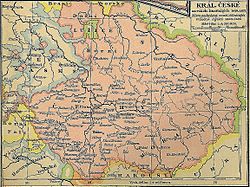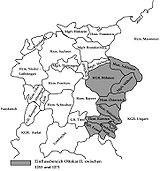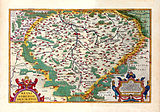- Kingdom of Bohemia
-
Kingdom of Bohemia
České království (cs)
Königreich Böhmen (de)
Regnum Bohemiae (la)Imperial elector
Part of Habsburg Empire (1620/27–1804)
Kronland of the Austrian Empire (1804–67)
Part of Cisleithanian Austria-Hungary (1867–1918)← 
1198–1918  →
→Coat of arms
Kingdom of Bohemia 1419–37 Capital Prague Language(s) Czech, German Religion Government Monarchy King - 1198–1230 (first)a Ottokar I of Bohemia - 1916–1918 (last) Charles I of Austria History - Kingdom established 1198 - Hereditary royal title
confirmed
26 September 1212- Inauguration of the
Luxembourg dynasty
7 April 1348- Became main part of
Bohemian Crown lands
5 April 1355- King confirmed Elector 25 December 1356 - Dissolution of Austro-
Hungarian Empire
31 October 1918Today part of a: Ottokar was third king of Bohemia, but the first with full hereditary title recognized by the Papacy and Holy Roman Empire[citation needed] The Kingdom of Bohemia (Czech: České království; German: Königreich Böhmen; Latin: Regnum Bohemiae) was a country located in the region of Bohemia in Central Europe, most of whose territory is currently located in the modern-day Czech Republic. The King was Elector of Holy Roman Empire until its dissolution in 1806, whereupon it became part of the Austrian Empire, and subsequently the Austro-Hungarian Empire from 1867. Following the defeat of the Central Powers in World War I, both Kingdom and Empire were dissolved and Bohemia became part of the newly formed Czechoslovak Republic.
Contents
History
Although some former rulers of Bohemia had enjoyed a non-hereditary royal title during the 11th and 12th century (Vratislaus II, Vladislaus II), the kingdom was formally established in 1198 by Ottokar I, who had his regality acknowledged by Philip of Swabia, elected King of the Romans, in turn for his support against the rival Emperor Otto IV. In 1204 Ottokar's royal dignity was accepted by Otto IV himself as well as by Pope Innocent III and afterwards definitely confirmed by the Golden Bull of Sicily issued by Emperor Frederick II in 1212, promoting the Duchy of Bohemia to the Kingdom status. Incorporated into the Habsburg Monarchy from 1526, it was dissolved in 1918 with the fall of Austria–Hungary, when the last Bohemian king, Charles I of Austria, was forced out of power without abdicating. The national assembly at Prague then deposed the Habsburg (Habsburg-Lorraine) dynasty and proclaimed the Czechoslovak Republic.
Bohemia proper (Čechy) with the County of Kladsko (Hrabství kladské) was the main area of the Kingdom of Bohemia and from 1348 Charles IV created Lands of the Bohemian Crown (Země Koruny české), together with the incorporated provinces:
- The March of Moravia (Markrabství moravské), acquired by Přemyslid and Slavník Bohemian rulers after the 955 Battle of Lechfeld, lost in 999 to Kingdom of Poland and reconquered by Duke Bretislaus I in 1019/1029 (uncertain dating);
- Upper Lusatia (Horní Lužice), incorporated by King John of Bohemia in 1319 (Bautzen) and 1329 (Görlitz), and Lower Lusatia (Dolní Lužice), former Margraviate of Lusatia), acquired by John's son Charles IV from Otto V, Margrave of Brandenburg in 1367. Ferdinand II of Habsburg lost the Lusatias to the Electorate of Saxony with the 1635 Peace of Prague;
- The Duchies of Silesia (Slezsko), acquired by the 1335 Treaty of Trentschin between Jan Lucemburský and King Casimir III of Poland. Queen Maria Theresa lost Silesia in 1742 to King Frederick II of Prussia by the Treaty of Breslau, with the exception of Austrian Silesia
and, at times:
- The Duchy of Austria in 1251, the Duchy of Styria in 1261, the Egerland in 1266, the Duchy of Carinthia with the March of Carniola and the Windic March in 1269 and the March of Friuli in 1272, all acquired by King Ottokar II Přemyslid and lost to Rudolph I of Germany in the 1278 Battle on the Marchfeld;
- The Egerland (Chebsko) was again obtained by Wenceslaus II between 1291–1305; definitely given in pawn to Bohemia by Emperor (then King of the Romans) Louis IV in 1322 and subsequently joined in personal union with Bohemia proper;
- The northern part of the Upper Palatinate ("New Bohemia") at Sulzbach, incorporated by Charles IV in 1355. Charles' son Wenceslaus lost the Upper Palatinate in 1400 to the Electoral Palatinate under King Rupert of Germany;
- The Brandenburg Electorate, acquired by Charles IV from Duke Otto V of Wittelsbach in 1373. Charles' son Sigismund lost Brandenburg in 1415 to Frederick I, Elector of Brandenburg.
 Prague Castle – the ancient seat of Bohemian dukes, kings and emperors; after 1918 office of the Czechoslovak and Czech presidents
Prague Castle – the ancient seat of Bohemian dukes, kings and emperors; after 1918 office of the Czechoslovak and Czech presidents
During the reign of the last Přemyslids and the succeeding House of Luxembourg the Bohemian kingdom was the most powerful state of the Holy Roman Empire.[citation needed] King Wenceslaus II was crowned King of Poland in 1300, his son Wenceslaus III King of Hungary one year later. Though both crowns were lost after Wenceslaus' III assassination in 1306, the rise of Bohemia continued, when in 1346 the heir to the Bohemian throne, Charles of Luxembourg was elected King of the Romans and crowned Holy Roman Emperor in 1355. The issue of the 1356 Golden Bull together with the following acquisition of the Brandenburg Electorate gave the Bohemian Kingdom two votes in the electoral college. Charles made Prague the Imperial residence and his son King Sigismund again acquired the Hungarian crown by marriage with queen regnant Mary of Hungary in 1385. His successors – Ladislaus the Posthumous from Habsburg dynasty, George of Podiebrad and the rulers of the Jagiellon dynasty – strengthening the status of Bohemia as an autonomous part of the Empire. In turn King Vladislav Jagiellon was disqualified by the prince-electors from taking part in the 1486 election of Maximilian I of Habsburg in 1486. The estrangement from the Empire continued after Vladislav had succeeded Matthias Corvinus of Hungary in 1490 and both the Bohemian and the Hungarian kingdom were held in personal union. Not considered an Imperial State, the Lands of the Bohemian Crown were not part of the Imperial Circles established by the 1500 Imperial Reform.
After the early death of King Louis II Jagiellon at the Battle of Mohács in 1526, the Bohemian kingdom was inherited by his brother-in-law, the Austrian Archduke Ferdinand I of Habsburg, younger brother of Emperor Charles V, whom he succeeded in 1558. The subsequent incorporation of Bohemia into the Habsburg Monarchy against the resistance of the local Protestant nobility sparked off the 1618 Defenestration of Prague and the Thirty Years' War. Their defeat at the Battle of White Mountain in 1620 put an end to the Bohemian autonomy movement.
With the dissolution of the Holy Roman Empire in 1806, the Bohemian kingdom was incorporated into the Austrian Empire and the royal title retained by the Emperor of Austria. In the course of the 1867 Austro-Hungarian Compromise the provinces of Bohemia, Moravia and Austrian Silesia became k. k. crown lands of Cisleithania.
The current Czech Republic consisting of Bohemia, Moravia and Czech Silesia still uses some symbols of the Kingdom of Bohemia: a two-tailed lion in its coat-of-arms, red-white strips in the state flag and the royal castle as the president's office.
Administrative division
Kraje of Bohemia
Kraje of Moravia
Lusatias
See also
- List of rulers of Bohemia
- Lands of the Bohemian Crown
- Crown of Saint Wenceslas
- History of the Czech lands
Notes
References
- Pánek, Jaroslav; Tůma Oldřich et al. (2009). A History of the Czech lands. Prague: Karolinum. ISBN 978-80-246-1645-2.
- Bobková, Lenka (2006) (in Czech). 7. 4. 1348 – Ustavení Koruny království českého: český stát Karla IV. (Founding of the Crown of Bohemian Kingdom: Czech State of Charles IV). Praha: Havran. ISBN 80-86515-61-3.
- Agnew, Hugh LeCaine (2004). The Czechs and the Lands of the Bohemian Crown. Stanford: Hoover Institution Press. ISBN 0-8179-4492-3.
 Members of the Electoral College of the Holy Roman Empire following the Golden Bull of 1356Added from 1803–06
Members of the Electoral College of the Holy Roman Empire following the Golden Bull of 1356Added from 1803–06 Prince of Regensburg
Prince of Regensburg
 Grand Duke of Salzburg (1803–05)
Grand Duke of Salzburg (1803–05)
 Grand Duke of Würzburg (1805–06)
Grand Duke of Würzburg (1805–06)
 Duke of Württemberg
Duke of Württemberg
 Margrave of Baden
Margrave of Baden
 Landgrave of Hesse-Kassel
Landgrave of Hesse-KasselProvinces of the Austrian Empire Kingdom of Bohemia · Kingdom of Hungary · Kingdom of Illyria · Kingdom of Dalmatia · Kingdom of Croatia-Slavonia · Kingdom of Galicia and Lodomeria · Kingdom of Lombardy and Venetia · Archduchy of Austria · Duchy of Carinthia · Duchy of Carniola · Duchy of Salzburg · Duchy of Upper and Lower Silesia · Duchy of Styria · Duchy of Bukovina · Voivodeship of Serbia and Banat of Temeschwar · Grand Principality of Transylvania · Margraviate of Moravia · Princely County of Tyrol with Vorarlberg · Austrian Littoral (Princely County of Gorizia and Gradisca · Margravate of Istria · Imperial Free City of Trieste) · Military Frontier
 Categories:
Categories:- Former monarchies of Europe
- Former countries in Europe
- States of the Holy Roman Empire
- States and territories established in 1198
- States and territories disestablished in 1918
- States and territories established in 1212
- 1918 disestablishments
- Bohemia
- Czech history
- Medieval Czech history
- Kingdoms and countries of Austria-Hungary
- Former Slavic countries
Wikimedia Foundation. 2010.






